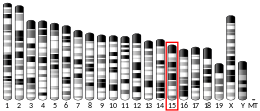R-spondin 2
R-spondin 2 also known as roof plate-specific spondin-2 is a protein that in humans that is encoded by the RSPO2 gene.[5]
R-spondin 2 synergizes with Wnt to activate beta-catenin.[6][7] RSPO2 has been proposed to regulate craniofacial patterning and morphogenesis within pharyngeal arch 1 through ectoderm-mesenchyme signaling via the endothelin-Dlx5/6 pathway.[8]
In dogs, a variant on the Rspo2 gene is associated moustache and eyebrow thickness.[9]
References
- GRCh38: Ensembl release 89: ENSG00000147655 - Ensembl, May 2017
- GRCm38: Ensembl release 89: ENSMUSG00000051920 - Ensembl, May 2017
- "Human PubMed Reference:". National Center for Biotechnology Information, U.S. National Library of Medicine.
- "Mouse PubMed Reference:". National Center for Biotechnology Information, U.S. National Library of Medicine.
- "Entrez Gene: R-spondin 2".
- Kim KA, Zhao J, Andarmani S, Kakitani M, Oshima T, Binnerts ME, Abo A, Tomizuka K, Funk WD (January 2006). "R-Spondin proteins: a novel link to beta-catenin activation". Cell Cycle. 5 (1): 23–6. doi:10.4161/cc.5.1.2305. PMID 16357527.
- Kazanskaya O, Glinka A, del Barco Barrantes I, Stannek P, Niehrs C, Wu W (October 2004). "R-Spondin2 is a secreted activator of Wnt/beta-catenin signaling and is required for Xenopus myogenesis". Dev. Cell. 7 (4): 525–34. doi:10.1016/j.devcel.2004.07.019. PMID 15469841.
- Jin YR, Turcotte TJ, Crocker AL, Han XH, Yoon JK (2011). "The canonical Wnt signaling activator, R-spondin2, regulates craniofacial patterning and morphogenesis within the branchial arch through ectodermal–mesenchymal interaction". Developmental Biology. 352 (1): 1–13. doi:10.1016/j.ydbio.2011.01.004. PMC 3089906. PMID 21237142.
- Cadieu E, Neff MW, Quignon P, Walsh K, Chase K, Parker HG, Vonholdt BM, Rhue A, Boyko A, Byers A, Wong A, Mosher DS, Elkahloun AG, Spady TC, André C, Lark KG, Cargill M, Bustamante CD, Wayne RK, Ostrander EA (October 2009). "Coat variation in the domestic dog is governed by variants in three genes". Science. 326 (5949): 150–3. Bibcode:2009Sci...326..150C. doi:10.1126/science.1177808. PMC 2897713. PMID 19713490.
This article incorporates text from the United States National Library of Medicine, which is in the public domain.
This article is issued from Wikipedia. The text is licensed under Creative Commons - Attribution - Sharealike. Additional terms may apply for the media files.



